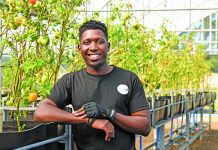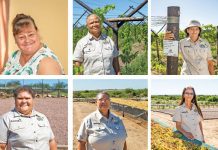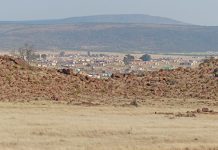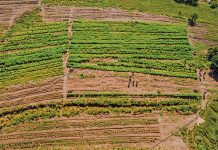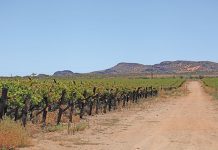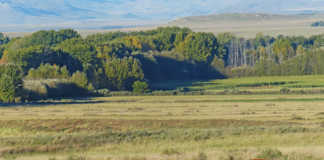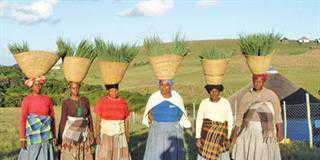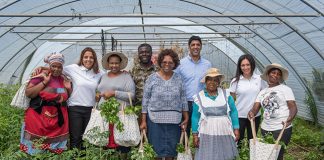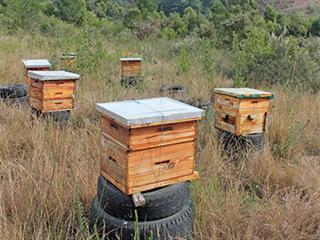
The small town of Friemersheim lies like a dusty pebble in the cradled palm of the Outeniqua Mountains, near George, in the southern part of the Western Cape. The town is located at the end of a gravel road, far from the main highway, and it seems unlikely that anyone ever passes through there by chance.
It seems a bit of a mystery how Reginald Jacobus and his wife Irma ended up moving here in 2008 after living in Kuils River near Cape Town for many years. But Reginald explains that Irma was born here and when they decided it was time to move from the city to the countryside, Friemersheim seemed as good a place as any.
High unemployment
Like so many other rural towns in South Africa, Friemersheim is plagued by high unemployment. Having done community work in rural areas for a large part of his life, Reginald soon saw the opportunity to make a difference. In an effort to address the needs of the community, he launched the Friemersheim Multi-Purpose Primary Co-operative (FMPC) in February 2011 with the aim of initiating sustainable economic activities that could have a positive impact on the lives of the people of Friemersheim.
Getting started
“We started with bee farming and the production of honey,” says Reginald. “There’ve always been many bees in the area because of the timber plantations and fynbos. In addition, some of the people in Friemersheim were keeping bees as a hobby. So bee- farming seemed a natural choice.”
With the help of bursaries provided by AgriSETA, 15 people from Friemersheim studied bee- keeping through the Southern Cape College. According to Reginald, 14 (five women and nine men) completed the course successfully. “Eight of us who completed the course are still farming with bees. Between us, we manage about 200 beehives, of which 60 are in full production,” he says.
A productive beehive
“Once a swarm of bees have been moved into the commercial beehive, one unit can reach full production within three months, as long as there’s enough nectar for the bees to feed on,” Reginald explains. The hive consists of two chambers. The first is the breeding chamber. No honey is ever harvested from here because this honey serves as food for the larvae.
“This chamber consists of 10 frames. Only when all of them have been filled with beeswax honeycomb do you add the second chamber, the honey super, which also consists of 10 frames,” says Reginald.
Before the commercial beehives are placed in the field to attract bees, each rack is fitted with beehive foundations. These can be made of plastic or pressed honeycomb beeswax. They provide a starting structure for bees to build their own cells.
Using these beehive foundations speeds up the process because bees can make quick work of building the honeycombs inside the breeding chamber.
“Full production is reached when you can add the honey super after the bees have finished building wax cakes in the breeding chamber of the hive,” explains Reginald. The bees move onto the honey super, which is also fitted with beehive foundations, and fill its frames with beeswax honeycomb. “Bees always need extra room for the colony to grow, so adding the super serves the dual purpose of giving them extra space as well as providing us with honey that we can harvest.”
Two nectar seasons
According to Reginald, one of the most important skills a beekeeper must learn is knowing where to position commercial beehives to attract and sustain the bees. “You have to look for a place where there’ll be enough food available for the bees all year round. We’re lucky that in this area we have two good nectar seasons. “The first is towards the end of winter when the eucalyptus trees, which grow here in abundance, are in flower, and the second is in the spring when the fynbos starts flowering.”
But, he says, the amount of nectar available during flowering depends largely on the weather. “If it’s too dry, there’ll probably not be enough food available for the bees. They’ll then need to be fed on a solution of equal parts water and sugar.” A simple plastic container, such as an empty two-litre cold drink bottle, can be fashioned into a feeder. About two litres of the sugar and water mixture can feed one bee colony for up to five days, according to Reginald.
Because the Friemersheim area has two nectar seasons, the farmers are able to harvest honey twice a year – in August and in December/January. “We’ve harvested as much a 1,5kg of honey from a single beehive before, but on average we get about 800g from each beehive,” says Reginald. The honey only gets harvested once all 10 frames in the honey super has been filled.
Harvesting honey
The bees seal the cells when they have filled them up and these have to be uncapped in order to harvest the honey. The racks are then placed in the honey extractor. During the harvesting process, Reginald and his team try to do as little damage as possible to the comb. Once all the honey has been extracted, the racks with fully-built combs can be returned to the beehive to be re-used by the bees.
After the honey has been extracted, it is passed through a strainer and placed in a settling tank. The honey is poured straight from here into the containers in which it is sold. “Our business is growing steadily. In the first year – 2011 – we harvested only 44kg of honey. Last year we harvested over 220kg and we hope to harvest more than 300kg of honey this year,” explains Reginald.
Future plans
The intention is to grow the business to approximately 1 000 commercial beehives, but their greatest obstacle to this is to find space for all the beehives on the farms around Friemersheim. “We’d like to diversify into providing pollination services to farmers in the area,” says Reginald. “There are many commercial seed growers in the region and we’re close enough to the Langkloof to provide fruit farmers with pollination services.”
He adds that they are also in the planning stages of adding a honeybush tea project as an agricultural activity for the co-operative’s members. “We hope that the activities of the co-op will provide viable employment and income for as many people in Friemersheim as possible,” he says. “I’ve seen too many small, rural towns racked by poverty because the community did not make a plan. We want the town to grow and thrive, and the people to be self-sufficient. To achieve this, we have to create our own opportunities.”
Contact Reginald Jacobus on 082 458 816.


